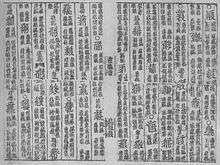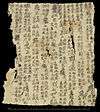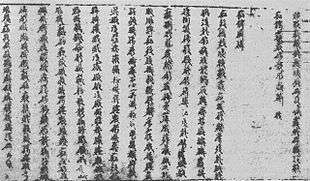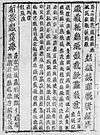List of Tangut books
This list of Tangut books comprises a list of manuscript and xylograph texts that are written in the extinct Tangut language and Tangut script. These texts were mostly produced within the Western Xia state (1038–1227) during the 12th and 13th centuries, and include Buddhist sutras and explanatory texts, dictionaries and other philological texts, as well as translations of Chinese books and some original Tangut texts. Some Tangut texts, particularly Buddhist sutras, continued to be produced during the Yuan Dynasty (1271–1368), after the fall of the Western Xia state, but the Tangut language became extinct sometime during the Ming Dynasty (1368–1644), and Tangut literature was only rediscovered in the early 20th century.
Most of the books listed here were discovered hidden in a stupa outside the city walls of the abandoned Western Xia fortress city of Khara-Khoto in Gansu by Pyotr Kuzmich Kozlov during his expedition of 1907–1909. A lesser number were recovered from Kahara-Khoto by Aurel Stein during his expedition of 1913–1916, and a few books have been found elsewhere in China.
Buddhist scriptures
A very large number of manuscript copies of Tangut translations of various Buddhist sutras are known, and in the table below only a single example copy is listed in most cases (when that is the case, the description is of the example copy).
| Image | Title | Description | Copies | Notes |
|---|---|---|---|---|
 |
Auspicious Tantra of All-Reaching Union (Chinese: 吉祥遍至口和本續; pinyin: Jíxiáng Biànzhì Kǒuhé Běnxù) |
Xylograph (12 vols.) | Ningxia Institute of Archaeology, Ningxia (9 vols.) | Translation of a Tibetan Tantric Buddhist text and commentary. Found at Baisigou Square Pagoda, Ningxia in 1991, and thought to be the earliest extant example of a book printed using wooden movable type.[1] |
 |
Compassionate Flower Sutra (Chinese: 悲華經; pinyin: Bēihuá Jīng) |
Xylograph | Translation of the Compassionate Flower Sutra (Karuṇā Puṇḍarīka) [Taishō #157]. | |
| The Dragon King of the Sea (Chinese: 海龍王經; pinyin: Hǎilóngwáng Jīng) |
Manuscript | British Library Or.12380/3621 | Translation of the short Buddhist text, The Question asked by the Dragon King of the Sea (Sāgara Nāgarāja Paripṛcchā) [Taishō #599].[2] | |
 |
Flower Garland Sutra (Chinese: 大方廣佛華嚴經; pinyin: Dàfāngguǎng Fóhuáyán Jīng) |
Xylograph | Translation of the Flower Garland Sutra (Mahāvaipulya Buddhāvataṃsaka Sūtra). | |
 |
Golden Light Sutra (Chinese: 金光明最勝王經; pinyin: Jīnguāngmíng Zuìshèngwáng Jīng) |
Chrysographic manuscript scroll | Translation of the Golden Light Sutra (Suvarṇaprabhāsa Sūtra), with Tangut lettering written in gold. | |
 |
Great Perfection of Wisdom Sutra (Chinese: 大般若波羅密多經; pinyin: Dà Bōrě Bōluómìduō Jīng) |
Manuscript leaves | IOM Tang.334/134 | Translation of the Great Perfection of Wisdom Sutra (Mahāprajñāpāramitā Sūtra). |
| Nirvana Sutra (Chinese: 大般涅槃經; pinyin: Dàbō Nièpán Jīng) |
Manuscript scroll | IOM Tang.335/2 | Translation of the Nirvana Sutra (Mahāparinirvāṇa Sūtra) [Taishō #374]. | |
 |
Wonderful Dharma Lotus Flower Sutra (Chinese: 妙法蓮華經; pinyin: Miàofǎ Liánhuá Jīng) |
Xylograph | Translation of the Lotus Sutra (Saddharma Puṇḍarīka) [Taishō #262]. | |
Dictionaries and philological works
| Image | Title | Description | Copies | Notes |
|---|---|---|---|---|
 |
Pearl in the Palm (Chinese: 番漢合時掌中珠; pinyin: Fān-Hàn Héshí Zhǎngzhōngzhū) |
Xylograph (1 vol.) | IOM (folios 1–37) Dunhuang Academy (folio 14b only) |
Bilingual Chinese-Tangut glossary with pronunciations of Chinese words in Tangut characters and pronunciations of Tangut words in Chinese characters.[3] |
 |
Sea of Characters (Chinese: 文海; pinyin: Wénhǎi) |
Xylograph (3 vols.) | IOM Nos. 211–213 (folios 4–93 and 2–22) | Monolingual Tangut rime dictionary, comprising one volume of level tone characters, one (now lost) volume of rising tone characters, and one volume of "mixed category" characters.[4] |
 |
Precious Rhymes of the Sea of Characters (Chinese: 文海寶韻; pinyin: Wénhǎi Bǎoyùn) |
Manuscript book (3 vols.) | IOM Nos. 4154, 8364 (folios 1–29, 1–18, 1–3) | Manuscript copy of an edition of the Sea of Characters rime dictionary (different from the printed edition). |
 |
Homophones (Chinese: 同音; pinyin: Tóngyīn) |
Xylograph (1 vol.) | IOM No. 207 (folios 1–56) IOM Nos. 208, 209, 4775 (folios 1–53) IOM No. 2619 (folios 27–31) IOM No. X1 (folios 1–33) |
Phonological text that lists Tangut characters that are homophones of each other. |
 |
Combined Edition of Homophones and Sea of Characters (Chinese: 同音文海寶韻合編; pinyin: Tóngyīn Wénhǎi Bǎoyùn Hébiān) |
Manuscript | IOM Nos. 4153, 4781, 6685, 8179, X2 IOM Nos. 7837, X3 (fragments) IOM No. 4152 (1 page) British Library Or.12380/2484, Or.12380/3907, Or.12380/3908 (fragments) |
Combined edition of the Homophones and the Sea of Characters. |
 |
Dissected Rhymes of the Five Sounds (Chinese: 五音切韻; pinyin: Wǔyīn Qiēyùn) |
Manuscript book | IOM No. 620 (38 folios) IOM No. 621 (28 folios) IOM No. 622 (28 folios) IOM No. 623 IOM No. 624 (33 folios) IOM No. 4154 IOM No. 5867 IOM No. 7192 |
Phonological text that gives tables of fanqie pronunciations for Tangut characters.[5] |
 |
Miscellaneous Characters (Chinese: 雜字; pinyin: Zázì) |
Xylograph (1 vol.) | IOM No. 210 (folios 4–93 and 2–22) | Classified lists of Tangut words.[6] |
 |
Newly Collected Grains of Gold or Golden Guide (Chinese: 碎金置掌文; pinyin: Suìjīn Zhìzhǎngwén) |
Manuscript | IOM No. 741 (10 folios) IOM No. 742V (incomplete, written on reverse of No. 741) Ningxia Provincial Archives B56:14 (28 fragments) British Library Or.12380/2581 (fragment) |
Poem comprising 200 five-character lines, in total 1,000 Tangut characters, each used a single time only; intended for use as a primer for teaching Tangut characters, in the same way that the Thousand Character Classic (千字文) was used to teach Chinese characters.[7][8] |
Original Tangut texts
| Image | Title | Description | Copies | Notes |
|---|---|---|---|---|
 |
The Sea of Meanings, Established by the Saints (Chinese: 聖立義海; pinyin: Shènglì Yìhǎi) |
Xylograph (15 vols.) | IOM Nos. 143–145, 684, 2614 (93 folios) [1182 ed.] | A leishu encyclopaedic book with topics arranged by category.[9] |
 |
Revised and Newly Endorsed Law Code for the Celestial Prosperity Era (Chinese: 天盛改舊新定律令; pinyin: Tiānshèng Gǎijiù Xīndìng Lǜlìng) |
Xylograph (20 vols.) | IOM (150 fragments from several editions) | The Western Xia law codes as established during the Celestial Prosperity era (1149–1169).[10] |
 |
Ode (Chinese: 賦詩; pinyin: Fù Shī) Great Ode |
Xylograph | IOM No. 121 (3, 6, 6, 9, 8 folios) | A collection of five poems written in ritual Tangut language. Ode on Monthly Pleasures was printed in 1185.[11] |
| Twenty-Five Answers Concerning the Buddhist Principles (Chinese: 佛理二十五問答; pinyin: Fólǐ Èrshíwǔ Wèndá) |
Xylograph (1 vol.) | IOM No. 186/2514, 2536, 2822 (and others) | 25 questions asked by Buddhist monks, and answered by the State Preceptor Tangchang. Various editions are extant, some with commentaries. One edition (#2822) was published in 1189.[12] | |
Translations of Chinese texts
| Image | Title | Description | Copies | Notes |
|---|---|---|---|---|
 |
The General's Garden (Chinese: 將苑; pinyin: Jiàng Yuàn) |
Manuscript scroll | British Library Or.12380/1840 | Translation of a Chinese military text, The General's Garden ascribed to Zhuge Liang.[13] |
 |
The Art of War (Chinese: 孫子兵法; pinyin: Sūnzǐ Bīngfǎ) |
Manuscript scroll | Ningxia Provincial Archives | Translation of a Chinese military text, The Art of War ascribed to Sun Tzu. |
 |
The Art of War (Chinese: 孫子兵法; pinyin: Sūnzǐ Bīngfǎ) |
Xylograph | British Library (2 pages only) | Translation of a Chinese military text, The Art of War ascribed to Sun Tzu.[14] |
| Newly Collected Biographies of Affection and Filial Piety (Chinese: 新集慈孝傳; pinyin: Zīnjí Cíxiào Zhuàn) |
Xylograph (2 vols.) | IOM No. 616 (2nd vol. only) | By Cao Daole. Translation of biographies of virtuous people from history (44 in the extant 2nd volume), mostly derived from Family Models 家范 by Sima Guang (1019–1086).[15] | |
 |
Analects (Chinese: 論語; pinyin: Lún Yǔ) |
Xylograph (10 chs.) | IOM Nos. 147, 148, 149, 784, 7215 (47 folios corresponding to parts of chs. 5, 11, 15, 19 and 20) | Translation of the Analects of Confucius, with commentary.[16] |
 |
Mencius (Chinese: 孟子; pinyin: Mèngzǐ) |
Manuscript | IOM Nos. 360, 767, 774, 952, 6753 (22 folios corresponding to parts of ch. 8) | Translation of the Mencius, with commentary.[16] |
 |
Mencius (Chinese: 孟子; pinyin: Mèngzǐ) |
Manuscript | IOM No. 6738 (57 fragments corresponding to parts of chs. 4, 5 and 6) | Translation of the Mencius, without commentary.[16] |
 |
Newly Translated Book of Filial Piety with Commentary (Chinese: 重譯孝經傳; pinyin: Chóngyì Xiàojīng Zhuàn) |
Manuscript | IOM No. 2627 | Translation of the Confucian text, Classic of Filial Piety, with commentary.[17][16] |
See also
| Wikimedia Commons has media related to Tangut printed texts, |
- Tangutology
- Cloud Platform at Juyongguan — 14th-century arch inscribed with Buddhist texts inscribed in Tangut and other languages
- Stele of Sulaiman — a 1348 stele at the Mogao Caves with the Buddhist mantra Om mani padme hum inscribed in Tangut and other languages
- Tangut dharani pillars — two dharani pillars inscribed with text of a dhāraṇī-sutra in Tangut script, dated 1502
References
- ↑ "Kingdom of Mystery (2)". China Daily. 21 December 2004. Retrieved 2011-09-17.
- ↑ Grinstead, E. D. (Spring 1967). "The Dragon King of the Sea". The British Museum Quarterly 31 (3/4): 96–100. doi:10.2307/4422969.
- ↑ "敦煌研究院藏国家珍贵古籍介绍(三)". Dunhuang Academy. 2011-01-05. Retrieved 2013-04-06.
- ↑ Shi, Jinbo; Bai, Bin; Huang, Zhenhua (1983). 文海研究 (Wenhai Yanjiu) [Studies on the Sea of Characters]. Zhongguo Shehui Kexue Chubanshe. p. 2.
- ↑ Li, Fanwen (2006). "《五音切韵》与《文海宝韵》比较研究 [Comparative study of the "Dissected Rhymes of the Five Sounds" and the "Precious Rhymes of the Sea of Characters"]". 西夏研究 [Tangut Studies] 1. Chinese Academy of Social Sciences. p. 6. ISBN 7-5004-5688-3.
- ↑ Li, Fanwen; Nakajima, Motoki (1997). 電脳処理西夏文雑字研究 [Research into the Computer Processing of the 'Miscellaneous Characters']. Kokuritsu A-Hi Gogen Bunka Kenkyūjo. pp. 17–20.
- ↑ Nie, Hongyin; Shi, Jinbo. "西夏文本《碎金》研究" [Study of the Tangut version of the 'Sui Jin']. Retrieved 2013-04-07.
- ↑ Miyake, Marc (17 May 2010). "The Golden Guide: Line 1: Tangraphs 1-5". Retrieved 2013-04-07.
- ↑ Kychanov, E. I. (1997). Море значений, установленных святыми [The Sea of Meanings, Established by the Saints]. Центр Петербургское Востоковедение. ISBN 5-85803-056-6.
- ↑ Kychanov, E. I. (1989). Изменённый и заново утверждённый кодекс девиза царствования: Небесное процветание (1149-1169) [The Revised and Newly Endorsed Code for the Designation of Reign ‘Celestial Prosperity’ (1149-69)]. Nauka. ISBN 5-02-016978-1.
- ↑ Nishida, Tatsuo (1986). "西夏語『月々楽詩』の研究" [Study of the Tangut language 'Poem on Pleasure of Every Month']. Memoirs of the Faculty of Letters Kyoto University 25: 1–116.
- ↑ Solonin, Kirill J. (2008). "'The Twenty-Five Answers Concerning the Buddhist Principles': A Tangut Buddhist Manual from St. Petersburg Tangut Collection". Written Monuments of the Orient 9 (2): 147–170. ISSN 1811-8062.
- ↑ Galambos, Imre (2010). "The Tangut translation of the General’s Garden by Zhuge Liang". Written Monuments of the Orient 14 (1): 131–142. ISSN 1811-8062.
- ↑ Grinstead, E. D. (December 1961). "Tangut Fragments in the British Museum". The British Museum Quarterly 24 (3/4): 82–87.
- ↑ Nie, Hongyin (2008). "Family Models: The Model of the Tangut Work 'Newly Collected Biographies of Affection and Filial Piety'". Written Monuments of the Orient 9 (2): 237–242. ISSN 1811-8062.
- 1 2 3 4 Kolokolov, V. S.; Kychanov, E. I. (1966). Китайская классика в тангутском переводе [Chinese Classics in Tangut Translation]. Nauka. pp. 147–148.
- ↑ Grinstead, Eric (1972). Analysis of the Tangut Script. Studentlitteratur. pp. 277–296. ISBN 91-44-09191-5.